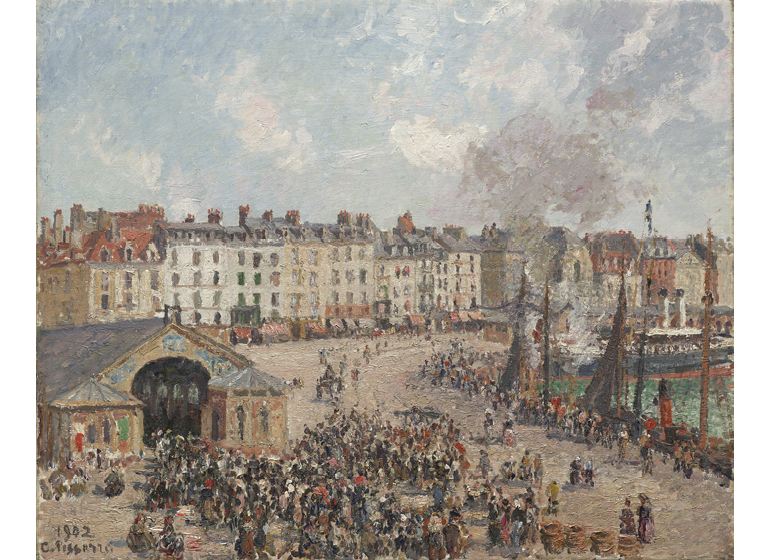CMA celebrates the Keithley collection with a reflection on community
Courtesy of The Cleveland Museum of Art
The vibrant colors of Camille Pissaro’s “Fishmarket” (1902) reflect the style of the Impressionist era. This and other artworks from this movement are featured in the Keithley collection at the CMA.
October 7, 2022
Nancy and Joseph Keithley are Cleveland-based philanthropists who have supported a variety of organizations—including Case Western Reserve University, where Mr. Keithley is a trustee emeritus—and have long been involved with the advancement of the Cleveland Museum of Art (CMA). In 2020, they announced their intention to donate over 100 pieces, the largest gift to the Museum since 1958. Their gift is commemorated in “Impressionism to Modernism: The Keithley Exhibit.” Reflecting on their donation, Mrs. Keithley states, “Cleveland is our home and we have enjoyed building our lives here. It is important to us to give back to our community, and we felt that the Cleveland Museum of Art was the perfect home for the works of art that we have assembled, cherished, and now joyfully made available to all.” The exhibit is as much a tribute to the celebrated artists of the Impressionist and Post-Impressionist era as it is to the donors whose commitment has bolstered the CMA, shaping it into the archive of great works that it is today.
The majority of the exhibit is a direct reflection of the Keithelys’ interest in Western Impressionist and modern art; however, the collection also includes a number of Japanese and Chinese ceramics, creating a unique experience rooted in many independent expressions. The exhibit progresses smoothly through rooms of art grouped by shared subject rather than chronological order, unfurling into ruminations on themes like “The Natural World Transformed” and “The American Landscape.” Famous names ring from every placard, but the number of works speaks louder. The exhibit calls upon viewers to submerge themselves within the frames and allow the art to tug upon emotions and memories hitherto unacknowledged. These paintings, prints, ceramics and sketches do not only recount explicit stories: They stage a moment and ask us to populate it with our own details, to willingly become lost in order to seek out a pinpoint of clarity as to what and who we have become. It is this expert embodiment of Impressionist, Post-Impressionist and Modernist ideals that makes this collection so remarkable, allowing it to serve as a bridge between preceding generations and the present day.
These works encapsulate the mid-19th century and the turn of the 20th century, an era marked by great successes in industrialisation and globalization, but marred by the effects of social stratification, shifting politics and World War I. Much of “The Keithley Exhibit” considers the active positions of the artists who lived in this period of global change, granting them the space to express their sentiments while actively engaging with their viewers, both contemporary and subsequent. The exhibit plays with parallels, often pairing similar works such as Henri Matisse’s “Tulips” from 1914 with Pieter Holsteyn II’s 17th century series “Study of a Tulip.” Matisse’s work contains a heavy sense of trepidation as the blooming tulips, and the world, hang on the precipice of WWI, while Holsteyn’s bulbs represent the Dutch tulip mania. Despite these differences, both embody reactions to events beyond personal control, whose all-consuming impact lends a palpable unease, yet simultaneous sense of conjecture, to the works. “Strandgade, Sunshine,” (1906) by Vilhelm Hammershøi, and “Nude Rising from Bed,” (1912) by Pierre Bonnard, both toy with the placement of women within domestic backdrops. Hammershøi gives his subject a rigid domain of her own while Bonnard reduces his leading lady to one of possessions, equating her nude form to the luxury of the brass bed and the clothes hanging in the closet behind her.
This collection is a fascinating bombardment of countless lives, all wound together in an intellectual feast that engages the mind, the eyes and the heart. It is undoubtedly an impressive group of works, but this does not come solely from the displayed skill.The pieces still hold value in that they allow for conversations and interactions between the people who occupy our ever-changing, yet unchanging world. The Keithleys’ donation reminds us that museums are built by and for communities whose intertwining histories have a richer composition than could ever be portrayed by paint. “Impressionism to Modernism: The Keithley Exhibit” is on display at the CMA until Jan. 8, 2023 and admission is free for all CWRU students.


